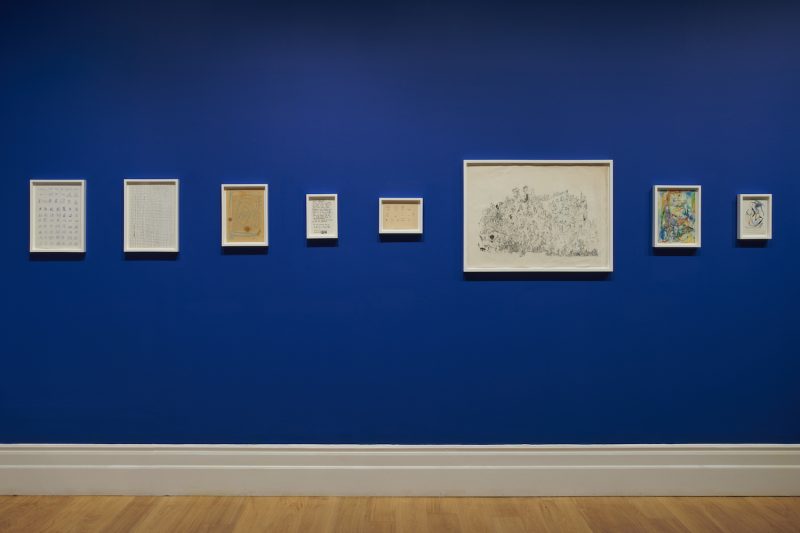A blue-walled room blitzed by scraps. Some are in frames, others displayed under glass like pinned butterflies. A collection of ephemera, fragments and parentheses: Untitled (Presumed Self-Portrait); Untitled (c. 1972-76); Untitled (‘The world of poetry inhabits and moves in a world of its own’); Untitled (‘my eroticism is stirred by paint’); Untitled (Relentless). The last constitutes a sequence of poems – or, perhaps, a single poem spread across several sites – scrawled in crayon on mottled paper. We read: ‘the barely distinguishable | lazuli line’. Elsewhere we find diary entries, keyless ideograms, illegible notebook pages; transient forms describing, again and again, the mind’s various recessions into itself.
This is the work of Anna Mendelssohn, sometimes known as Grace Lake. Earlier this year the Whitechapel Gallery in London held the first institutional display of her work. It was a small, representative selection from an immense oeuvre, loaned from the archive at the University of Sussex, which houses over 770 of her notebooks. Mendelssohn remains a relatively marginal figure in the history of British poetry and visual art; despite an affiliation with the so-called Cambridge School, she always pursued her own deeply idiosyncratic path. Two significant collections of her poetry have been published: Implacable Art (2000) and I’m Working Here (2020), the latter stretching to some 780 pages. Each shows the same compulsion to work: to write poem after poem of fractious elegance (‘There is nothing wrong with a high heart / As long as it hangs not alone’); to affirm the most precarious statements of presence (‘I used to have words. Now they are absent’); to etch linguistic-political affinities (‘Out of true for nothing in common where all knowledge is blacked’).
Born in 1948 and raised in Stockport, Mendelssohn became notorious when she was tried in 1972 as one of the ‘Stoke Newington Eight’ for allegedly taking part in a series of bombings associated with the Angry Brigade. She was sentenced to ten years in prison and served five. Until her death in 2009, she maintained her innocence and aversion to violence, political or otherwise. The experience naturally left a mark. In its aftermath, she produced writing that insists on self-intimacy, conflates private life and perjury, and routinely eludes recognisable forms of utterance:
of minds, of flues, or organza.
breath cloaked in paintings;
old roman pavement oak leafed
a narrow step to the pond, her children
slammed against the water, against her
leaving dust for sea, smoke for sunlight.
Wary of unambiguous statement, Mendelssohn clung to an intense privation of meaning which produced a resistant, indeterminate art: working against the law, against capital, ‘against her’, against you: a ‘mouth closed against political language’. In a 1972 television interview, when questioned directly about her politics, Mendelsson’s answer was intransigent yet uttered gently: ‘Revolutionary’.
Crucial to Mendelssohn’s quiet revolution is an emphasis on the artwork’s materiality. Her work resembles off-cuts, disjecta, composed on whatever happened to be to hand, bearing with it a sense of precarity and imminent loss. Reminiscent, perhaps, of Dickinson’s envelope poems or Beckett’s mirlitonnades, Mendelssohn’s works are as easily trash as treasure. It is a practice consumed by ‘a terrible guilt complex over composition’, as one poem has it. Of course, ‘guilt’ is a vexed word for Mendelssohn, and her works are at once acts of dissent and testaments to vulnerability. There is an anxiety in such a transformative – or revolutionary – approach to one’s material environment. Every shred of paper is potentially poetry; the world is endlessly sensitive to her presence. Yet her imprimatur always carries a risk: it was Mendelssohn’s fingerprints, after all, found on a copy of Rolling Stone used to wrap a bomb planted at the Italian consulate in Manchester, which led to her incarceration in Holloway Prison.
One guard against incrimination is unreadability. Mendelssohn deploys various effects to sabotage conventional forms of knowing. There is her derangement of grammatical sense. We might also include her stupefying prolixity, as well as her work’s traversal of genres and mediums – as poem becomes drawing becomes letter becomes poem again – and her recourse to redaction and handwritten illegibility. It is as though their secrets are too precious, and potential misinterpretations too terrifying. The Whitechapel exhibition made some attempt to clear up these illegible moments. But even these are fundamentally uncertain. One transcription requires a square-bracketed parenthesis: ‘[unclear word, possibly azure or aura]’. It is a light touch of ineluctable doubt, balancing the work between possible words and worlds.
Read On: Terry Eagleton, ‘The Poetry of Radical Republicanism’, NLR I/158.
